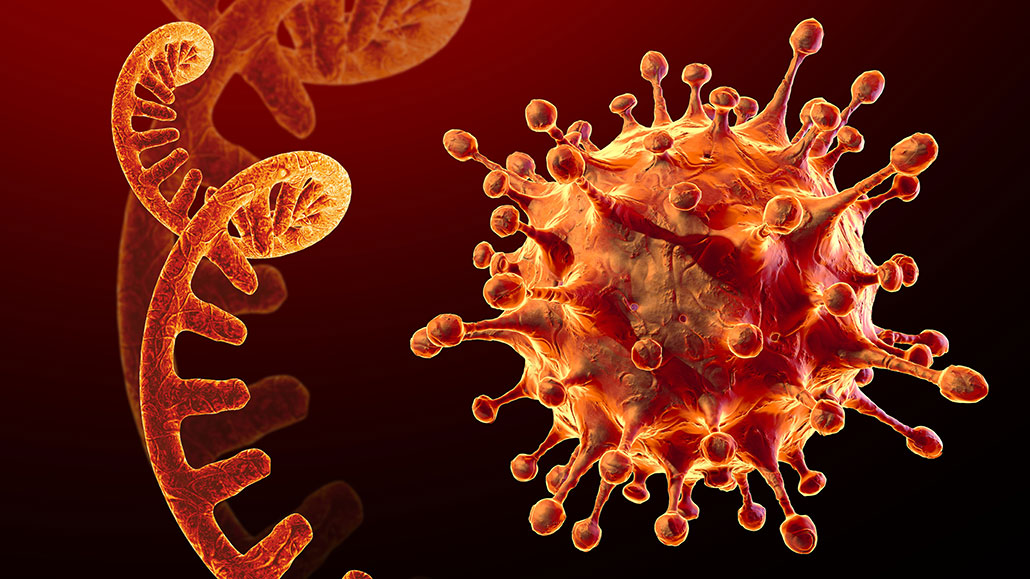

DNA is the genetic material that serves as our body’s genetic blueprint. DNA is short for deoxyribonucleic (Dee-OX-ee-ry-boh-nu-KLAY-ik) acid. It tells cells how to make all the proteins that will be needed for the body to survive. DNA receives a lot of attention, but it wouldn’t work without a key partner: RNA. That’s short for ribonucleic (RY-boh-nu-KLAY-ik) acid.
To understand the DNA-RNA partnership, imagine an instruction manual titled How to Build a Car. The manual shows the proper steps to build a car, but just having that book won’t produce a car. Something, or someone, must carry out the labor. RNA performs that action for cells. It puts the information stored in DNA’s twisting, ladder-like shape to use.
Proteins are the body’s workforce. They carry out the specialized, molecular-level tasks in all living things. Our blood moves life-sustaining oxygen to cells throughout the body. To do this, it uses the protein hemoglobin. Our digestive system breaks down what we eat into usable bits using other proteins. For instance, amylase (AA-mih-lays), a protein in saliva, breaks the starch in breads and potatoes down into sugars. Our bodies are built from many types of molecules, and it uses specific proteins that make those molecules.
To know which proteins to make, when to make them and where, the body relies on its instruction manual, DNA. RNA follows those instructions to make proteins. But RNA isn’t just one molecule. Here we focus on three major types.
 the process of making proteins" width="1030" height="1272" />
the process of making proteins" width="1030" height="1272" />
mRNA: Protein creation starts inside a cell’s nucleus. That’s where the DNA sits. A cell copies DNA’s instructions — a process scientists call transcription — onto a strand of messenger RNA, or mRNA. It’s a good name, because mRNA is a message. Once created, it exits the nucleus, leaving the DNA safe inside.
rRNA: Outside a cell’s nucleus, the mRNA binds to what’s known as rRNA. That’s short for ribosomal (Ry-boh-SOAM-ul) RNA. Its job is to decrypt the message in mRNA and use that information to build a new protein. Proteins are made of subunits called amino acids. rRNA snaps amino acids together in the proper order. rRNA wouldn’t know the right order without mRNA, so they work as a team. This step is called translation.
tRNA: Transfer RNA, or tRNA, acts like a taxi. It ferries amino acids from areas throughout the outer portions of a cell (its cytoplasm) over to the builder-molecule: that rRNA.
Together, this RNA trio works together to create the proteins living things need to function.
RNA has gotten a lot of attention in the last couple of years. In 2020, COVID-19 turned a spotlight on RNA. Viruses are not cells. They do, however, carry their own genetic instruction books. The coronavirus responsible for COVID-19 is an RNA-based virus. That means its genetic instruction book is made from RNA, not DNA.
And the first vaccines approved to fight COVID-19 were a new type: They focused on mRNA. It makes sense that RNA plays a role in immunity. The body’s immune system launches specialized proteins to fight off germs. In 2020, scientists working for a drug company known as Pfizer developed the first RNA vaccine that would go on to receive full approval from the U.S. Food and Drug Administration. One or more other RNA vaccines could be approved soon.
Vaccines work by tricking the immune system into thinking a pathogen is present. The immune system now mounts a defense. It dispatches an army of troops to circulate throughout the blood and track down more invaders. However, even after a pathogen — or an imposter (vaccine) — is gone, our bodies remember what the invader had looked like.
The immune system can remain on high alert scouting for that pathogen. If it appears once more, the body identifies it by its unique external features, called antigens. Then the immune system again mounts an immediate defense. Usually, this rapid response kills off the pathogen before we were even aware it had invaded the body.

Weekly updates to help you use Science News Explores in the learning environment
Thank you for signing up!
There was a problem signing you up.
A traditional vaccine works by exposing the body to a pathogen (usually killed or weakened) or pathogen look-alike. Even a dead pathogen can trigger an immune response because it still has the antigens on its surface that alarm the body’s defense troops. If the real pathogen later reappears, the vaccine is ready — primed — to attack.
mRNA vaccines work differently. Instead of introducing a pathogen or look-alike, mRNA vaccines pass on the mRNA instructions for making one of the pathogen’s antigens — and only that antigen. But that’s enough for the body to learn what to look out for. For the COVID-19 vaccine, those mRNA molecules give the body instructions that help it scout for signs of the virus’s spike protein.
“When that mRNA gets into our cells, it then produces over and over again copies of that spike protein,” explains Gregory A. Poland. He’s a vaccine scientist at the Mayo Clinic in Rochester, Minn. That particular spike protein is found only on the outside of the virus that causes COVID-19.
Once someone receives a shot of an mRNA vaccine, the rRNA and tRNA in their cells start translating the vaccine’s mRNA into a protein — the antigen. That tricks the immune system into thinking the virus has infected the body. In that way, the vaccine gets the body to develop the defensive troops it needs to hunt down and kill the real coronavirus if and when the real virus shows up.
amino acids: Simple molecules that occur naturally in plant and animal tissues and that are the basic building blocks of proteins.
amylase: An enzyme that breaks starches down into the sugars from which they had been made.
antigen: A substance capable of triggering an immune reaction.
cell: The smallest structural and functional unit of an organism. Typically too small to see with the unaided eye, it consists of a watery fluid surrounded by a membrane or wall. Depending on their size, animals are made of anywhere from thousands to trillions of cells.
coronavirus: A family of viruses named for the crown-like spikes on their surface (corona means “crown” in Latin). Coronaviruses cause the common cold. The family also includes viruses that cause far more serious infections, including SARS and COVID-19.
COVID-19: A name given to the disease that erupted into a massive global pandemic in 2020. It first emerged in 2019 and is caused by a new coronavirus known as SARS-CoV-2. Symptoms can include pneumonia, trouble breathing, feeling too tired to walk more than a few steps, fever, headaches, low blood-oxygen levels, blood clots and brain “fog.”
cytoplasm: The liquid or jellylike material that makes up most of a cell and exists outside of its nucleus. Some important functional components of a cell exist in this cytoplasm, such as mitochondria, which break down nutrients and convert them into a form of useful energy.
defense: (in biology) A natural protective action taken or chemical response that occurs when a species confronts predators or agents that might harm it. (adj. defensive)
develop: To emerge or to make come into being, either naturally or through human intervention, such as by manufacturing. (in biology) To grow as an organism from conception through adulthood, often undergoing changes in chemistry, size, mental maturity or sometimes even shape.
DNA: (short for deoxyribonucleic acid) A long, double-stranded and spiral-shaped molecule inside most living cells that carries genetic instructions. It is built on a backbone of phosphorus, oxygen, and carbon atoms. In all living things, from plants and animals to microbes, these instructions tell cells which molecules to make.
genetic: Having to do with chromosomes, DNA and the genes contained within DNA. The field of science dealing with these biological instructions is known as genetics. People who work in this field are geneticists.
germ: Any one-celled microorganism, such as a bacterium or fungal species, or a virus particle. Some germs cause disease. Others can promote the health of more complex organisms, including birds and mammals. The health effects of most germs, however, remain unknown.
hemoglobin: A protein molecule that binds to oxygen in the blood, carrying it around to tissues.
immune system: The collection of cells and their responses that help the body fight off infections and deal with foreign substances that may provoke allergies.
immunity: (adj. immune) The ability of an organism to resist a particular infection or poison by providing cells to remove, kill or disarm the dangerous substance or infectious germ.
messenger RNA: Also known as mRNA. A type of genetic material that is copied from DNA. This mRNA carries the instructions for building a cell’s proteins.
molecule: An electrically neutral group of atoms that represents the smallest possible amount of a chemical compound. Molecules can be made of single types of atoms or of different types. For example, the oxygen in the air is made of two oxygen atoms (O2), but water is made of two hydrogen atoms and one oxygen atom (H2O).
nucleus: Plural is nuclei. (in biology) A dense structure present in many cells. Typically a single rounded structure encased within a membrane, the nucleus contains the genetic information. (in astronomy) The rocky body of a comet, sometimes carrying a jacket of ice or frozen gases. (in physics) The central core of an atom, containing most of its mass.
oxygen: A gas that makes up about 21 percent of Earth's atmosphere. All animals and many microorganisms need oxygen to fuel their growth (and metabolism).
pathogen: An organism that causes disease.
protein: A compound made from one or more long chains of amino acids. Proteins are an essential part of all living organisms. They form the basis of living cells, muscle and tissues; they also do the work inside of cells. Among the better-known, stand-alone proteins are the hemoglobin (in blood) and the antibodies (also in blood) that attempt to fight infections. Medicines frequently work by latching onto proteins.
RNA: A molecule that helps “read” the genetic information contained in DNA. A cell’s molecular machinery reads DNA to create RNA, and then reads RNA to create proteins.
starch: A soft white chemical made by all green plants. It’s a relatively long molecule made from linking together a lot of smaller, identical building blocks — all of them glucose, a simple sugar. Plants and animals use glucose as an energy source. Plants store that glucose, in the form of starch, as a reserve supply of energy. Animals that consume starch can break down the starch into glucose molecules to extract the useful energy.
transfer RNA: (Also known as tRNA) A type of RNA (ribonucleic acid) molecule that a cell uses to read a section of messenger RNA. This takes place during the production of a cellular protein.
unique: Something that is unlike anything else; the only one of its kind.
vaccine: (v. vaccinate) A biological mixture that resembles a disease-causing agent. It is given to help the body create immunity to a particular disease. The injections used to administer most vaccines are known as vaccinations.
virus: Tiny infectious particles consisting of genetic material (RNA or DNA) surrounded by protein. Viruses can reproduce only by injecting their genetic material into the cells of living creatures. Although scientists frequently refer to viruses as live or dead, in fact many scientists argue that no virus is truly alive. It doesn’t eat like animals do, or make its own food the way plants do. It must hijack the cellular machinery of a living cell in order to survive.
Journal: N. Pardi et al. mRNA vaccines — a new era in vaccinology. Nature Reviews Drug Discovery. January 12, 2018; Vol. 17, p. 261. doi: 10.1038/nrd.2017.243.
Podcast: Mayo Clinic. How Messenger RNA Vaccines Work (COVID -19 YouTube Miniseries, Episode 56). December 1, 2020.

Katie Grace Carpenter is a science writer and curriculum developer, with degrees in biology and biogeochemistry. She also writes science fiction and creates science videos. Katie lives in the U.S. but also spends time in Sweden with her husband, who’s a chef.
Free educator resources are available for this article. Register to access:
Already Registered? Enter your e-mail address above.